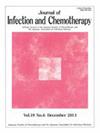Selection and evaluation of suitable quality control strains for meropenem antimicrobial susceptibility testing through preliminary external quality assessment
IF 1.9
4区 医学
Q3 INFECTIOUS DISEASES
引用次数: 0
Abstract
Background
Quality control (QC) of carbapenem susceptibility testing for Gram-negative bacteria faces challenges due to limited measuring ranges and the lack of suitable QC strains. This study aimed to select and evaluate QC strains for meropenem antimicrobial susceptibility testing (AST) through a pilot external quality assessment (EQA).
Methods
Candidate QC strains for meropenem AST were selected based on primary AST data and genomic information from the Japan Antimicrobial Resistant Bacterial Bank. Phenotype stability was verified through serial passaging and MIC comparison with original strains. The validated broth microdilution method was used to determine the target MIC value in a pilot EQA involving 47 clinical laboratories in Japan using ten different AST methods.
Results
Two strains, Citrobacter freundii JBBDAJB-19-0032 (Strain-A) and Enterobacter hormaechei subsp. steigerwaltii JBEBAAB-19-0102 (Strain-B), both carrying blaIMP-1, were selected as candidate QC strains. The meropenem MICs for Strain-A and Strain-B were 4 mg/L and 2 mg/L, respectively. In the pilot EQA, 43 laboratories reported appropriate results for Strain-A and 40 laboratories reported appropriate results for Strain-B. The MIC range was 2–8 mg/L for Strain-A and 1–4 mg/L for Strain-B. However, 19 and 12 laboratories, respectively, reported out-of-range MICs using AST plates on the MicroScan WalkAway. Inappropriate results were reported by four and seven laboratories, respectively, using common methods for Strain-A and Strain-B, respectively.
Conclusions
The candidate QC strains selected for this study are suitable for meropenem AST EQA, except when the measuring range of certain methods does not match their QC range.
通过初步外部质量评估,为美罗培南抗菌药物敏感性测试选择和评估合适的质量控制菌株。
背景:由于测量范围有限和缺乏合适的质控菌株,革兰氏阴性菌碳青霉烯类药敏试验的质控(QC)面临挑战。本研究旨在通过试点外部质量评估(EQA),选择和评估美罗培南抗菌药物敏感性检测(AST)的质控菌株:方法: 根据 AST 原始数据和日本抗菌药物耐药性细菌库的基因组信息,筛选出用于美罗培南 AST 的 QC 候选菌株。通过连续传代和与原始菌株的 MIC 比较来验证表型的稳定性。在一项试点 EQA 中,使用经过验证的肉汤微量稀释法确定目标 MIC 值,这项试点 EQA 涉及日本 47 个临床实验室,使用了 10 种不同的 AST 方法:结果:两株均携带 blaIMP-1 的柠檬酸杆菌 JBBDAJB-19-0032(菌株-A)和肠杆菌 hormaechei 亚种 steigerwaltii JBEBAAB-19-0102(菌株-B)被选为候选质控菌株。菌株-A 和菌株-B 的美罗培南 MIC 值分别为 4 mg/L 和 2 mg/L。在试点 EQA 中,43 个实验室报告了菌株 A 的适当结果,40 个实验室报告了菌株 B 的适当结果。菌株 A 的 MIC 范围为 2-8 mg/L,菌株 B 为 1-4 mg/L。然而,分别有 19 和 12 个实验室报告了使用 MicroScan WalkAway 上的 AST 平板的 MIC 值超出范围。使用普通方法检测菌株 A 和菌株 B 时,分别有 4 家和 7 家实验室报告了不恰当的结果:本研究选择的候选质控菌株适用于美罗培南 AST EQA,除非某些方法的测量范围与其质控范围不匹配。
本文章由计算机程序翻译,如有差异,请以英文原文为准。
求助全文
约1分钟内获得全文
求助全文
来源期刊

Journal of Infection and Chemotherapy
INFECTIOUS DISEASES-PHARMACOLOGY & PHARMACY
CiteScore
4.10
自引率
4.50%
发文量
303
审稿时长
47 days
期刊介绍:
The Journal of Infection and Chemotherapy (JIC) — official journal of the Japanese Society of Chemotherapy and The Japanese Association for Infectious Diseases — welcomes original papers, laboratory or clinical, as well as case reports, notes, committee reports, surveillance and guidelines from all parts of the world on all aspects of chemotherapy, covering the pathogenesis, diagnosis, treatment, and control of infection, including treatment with anticancer drugs. Experimental studies on animal models and pharmacokinetics, and reports on epidemiology and clinical trials are particularly welcome.
 求助内容:
求助内容: 应助结果提醒方式:
应助结果提醒方式:


